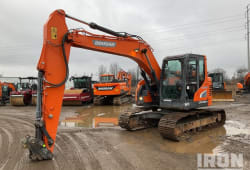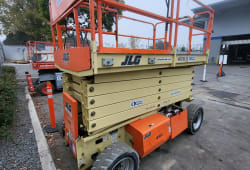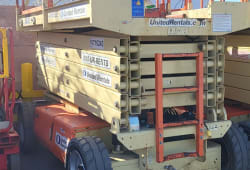Techniques How to Get a Piece of the $1T Infrastructure Bill
10 Min read
)
October 24, 2022
The government recently passed a new infrastructure bill for over $1 trillion. This will be one of the largest upgrades to our highways, roads, and other transportation infrastructure in this generation. With billions of dollars being invested in mitigating climate change and rebuilding our public works interstate highway system, the hope is that the major upcoming projects will produce thousands of jobs for Americans. This bipartisan legislation is called the Infrastructure Investment and Jobs Act and will kick off countless essential projects across the country. These major projects will offer work and financial stability for organizations who are seeking long-term projects, rather than relying on their backlogs for upgrades and repairs.
Many organizations are wondering what the new bill means for them, and how they can prepare their construction firm for the upcoming changes. Let's dive in.
Since the bill was passed, $110 billion of the $1 trillion budget in infrastructure funds have been released. Over 3,000 communities have benefitted so far from the massive bill, having received bridge and tunnel reconstruction, new buses, and improvements to airports.
The bill has allocated $110 billion for road work, $65 billion for more widespread and affordable broadband internet, $66 billion for railways, $55 billion to improve water, water and wastewater infrastructure, $25 billion for airports, $39.2 billion for new transit, and $5 billion to create electric vehicle charging stations.
How the Infrastructure Bill Will Affect the Construction Industry
This legislation is expected to also create jobs with a 5 percent increase in construction spending in the upcoming year, with another 5.5 percent increase projected future economic growth in the following year in 2023. Over the next ten years, the White House anticipates that the new bill will generate 1.5 million new jobs.
How Will the Construction Industry Adapt?
The new bill is expected to increase the demand for both engineering and design jobs. It is estimated that approximately 82,000 full- and part-time jobs in engineering and design will be required, leading to a $416 billion output by 2026. This means that more money will be invested, therefore creating more jobs. However, many are wondering how the construction industry, already fraught with labor shortages, material shortages, and supply chain issues, will adapt to this increased demand. Many of the upcoming projects, such as building electric vehicle charging stations, will require professionals across various industries, including the construction industry.
A New Interest in Construction Jobs
The new infrastructure bill is expected to jumpstart more interest in the well-paying careers available in the construction industry. As new projects arise, there will likely be a demand for new jobs that don't currently exist. With so many non-traditional infrastructure upgrades, including a $65 million investment in broadband internet/internet upgrades, the physical infrastructure bill is expected to create a variety of new job opportunities for skilled workers across all regions of the country.
With an increased demand for skilled workers, we are likely to see more promotion and development of construction-related degree programs. Some AEC firms are partnering with universities to fund research, create new programs, and mentor construction students. These measures will help prepare the industry for the influx of work, and help close the gap between the labor shortage and the demand for skilled workers.
More Facts on Bipartisan Infrastructure Bill
The period from July 8 to August 18 marked a pivotal moment for the United States with the passage of a $ 1 trillion bipartisan infrastructure bill. This legislation, commonly known as the bipartisan bill, reflects a united front in addressing the nation's infrastructure needs. The $ 1 trillion bipartisan infrastructure package is a product of collaborative efforts that is a bipartisan effort to cut across political differences and prioritize critical areas of development.
1. Infrastructure Investment
At its core, the bill focuses on significant infrastructure investment, injecting much-needed funds into the nation's roads and key sectors. These major new investments, ranging from transportation to water systems, aim to revitalize and modernize the country's infrastructure. The bill not only addresses longstanding issues but sets the stage for a more robust and resilient foundation for economic growth.
One notable aspect of bipartisan effort is the bipartisan nature of the bill, exemplifying a cooperative spirit in a time of political polarization. With a vote count of 68 to 13, the bill successfully passed muster, a bipartisan package showcasing a rare instance of agreement across party lines. This bipartisan support underscores the shared recognition among lawmakers of the urgent need to address infrastructure challenges for the benefit of the nation's roads everywhere.
2. Bipartisan Infrastructure Bill
Wastewater infrastructure and water systems emerge as crucial components of the bipartisan infrastructure bill. The bipartisan plan and allocation of resources to upgrade and maintain these essential elements underscores a commitment to providing clean and reliable water sources. Such provisions align the president's infrastructure plan with the broader goal of ensuring sustainable and resilient infrastructure for the future.
3. Provisions in Bipartisan Bill
In addition, the bipartisan bill includes provisions for passenger rail, emphasizing public transit as a commitment to enhancing transportation infrastructure. Recognizing the importance of efficient and sustainable, public transit systems and options, the bill positions public transit and passenger rail as a vital component of the nation's evolving transportation network.
For many, the bipartisan bill is synonymous with the president's signature issue, reflecting a dedicated focus on addressing the nation's pressing infrastructure challenges. As the bill awaits a final vote and the president's signature, it symbolizes a cooperative stride towards a more connected, efficient, and resilient American with a trillion bipartisan infrastructure bill.
Senators Role
On the Senate floor, Democratic senators pushed for the Jobs Act, a comprehensive initiative aimed at addressing climate change and fostering job growth. Despite strong opposition from Republicans, a bipartisan effort rose as negotiators from both parties worked to find common ground. The Congressional Budget Office played a crucial role in evaluating the proposed tax breaks, but senators rejected some ideas during the negotiation process. This legislative dance reflects the ongoing struggle between Democrats and Republicans on key policy issues, emphasizing the challenges and complexities involved in navigating a path forward in the pursuit of bipartisan solutions.
President Biden's infrastructure plans have been a subject of intense debate, evolving from a strictly partisan pursuit to a potential avenue for bipartisan cooperation. The proposed procedural vote on the infrastructure bill raised concerns among deficit hawks, particularly with the substantial expenditures involved in the massive bill. Notably, Republican Senator Rob Portman, a key figure in negotiations, has been working towards bridging the political gap during what seemed like an eternal "Infrastructure Week."
Within the proposed infrastructure plan itself, there is a delicate balance to strike, considering projected federal levels and the need to raise revenue. The mention of a new gas tax has sparked discussions, with some Republican senators wary of potential implications for rural America. Support for the infrastructure plans is largely held, with careful considerations for issues beyond transportation, such as health care and unemployment assistance. As negotiations unfold, the challenge lies in finding common ground to address the nation's crumbling infrastructure while navigating the diverse concerns of various stakeholders in a bid to build a more resilient and interconnected future.
Here's a table summarizing how construction companies can position themselves to get a piece of the $1 trillion infrastructure bill:
:format(webp)) These strategies outline actionable steps that construction companies can take to position themselves effectively and capitalize on the opportunities presented by the $1 trillion infrastructure bill. By leveraging bipartisan collaboration, emphasizing skilled workforce, and staying agile in responding to market demands, construction firms can enhance their competitiveness and secure contracts in this landmark infrastructure initiative.
These strategies outline actionable steps that construction companies can take to position themselves effectively and capitalize on the opportunities presented by the $1 trillion infrastructure bill. By leveraging bipartisan collaboration, emphasizing skilled workforce, and staying agile in responding to market demands, construction firms can enhance their competitiveness and secure contracts in this landmark infrastructure initiative.
How You Can Get In On the Action
Now that we've discussed how the money will be allocated, you're probably wondering how you can get in on the action. How can you put your business in a position to win contracts allowing you to take advantage of this funding?
The first step will be to register your business with organizations that will improve your visibility and boost your credibility. Begin by registering your business on the System for Award Management (SAM) database, and create a profile that government procurement officers can use to find your business. Once you've completed that step, you'll want to get yourself on the pre-approved bidder list on the General Services Administration (GSA). When you secure a contract with the GSA, you will "get onto the GSA schedule", meaning you are approved to do business with the government.
During this process, you will apply for a DUNS number, since anyone wanting to do business with the government will require a unique entity identifier (UEI). The DUNS number, which is the official UEI, is a nine-character identification number that is unique to you and provided by Dun & Bradstreet (D&B).
Once you're registered, you'll want to start small as you bid for government contracts. Past performance is one of the top factors that government agencies consider. To prove your abilities, you'll want to begin by bidding on contracts that you are confident in, can deliver quickly, and where you can provide the most value. This will help build your credibility and make your services more appealing to potential buyers. Remember that it's always better to under-promise and over-deliver to exceed expectations, rather than overcommitting and under-delivering on your promise.
Government infrastructure projects are typically complex, and often require several subcontractors across a variety of industries to complete. Seek out tasks that are well within your wheelhouse that match your expertise to make a name for yourself and build up your reputation.
In a rare display of bipartisan collaboration, Republican and Democratic senators came together to pass a historic trillion-dollar bipartisan infrastructure bill, overcoming the hurdles of filibuster threats and advancing legislation crucial for the nation's future. The Senate approved this landmark bill, transcending political divides and echoing a departure from the contentious political climate of former President Donald Trump's era. The bipartisan nature of this accomplishment, in the face of filibuster challenges, stands as a testament to the senators' commitment to addressing the country's pressing infrastructure needs, signaling a shift towards cooperative governance and a departure from the gridlock that marked the political landscape during former President Donald Trump's tenure.
The demand for skilled construction workers is at an all-time high. With these strategies, you'll be able to position yourself to get a piece of the new infrastructure bill if you are a growing construction business in 2022. This is an exciting opportunity to build and expand your business, build your reputation, and become a force in the construction industry.

Post acquisition of Boom & Bucket, the company he founded, Adam now leads Marketplace Growth for Ritchie Bros.














